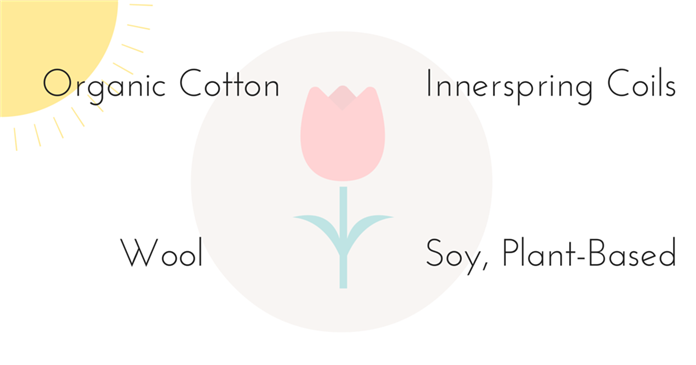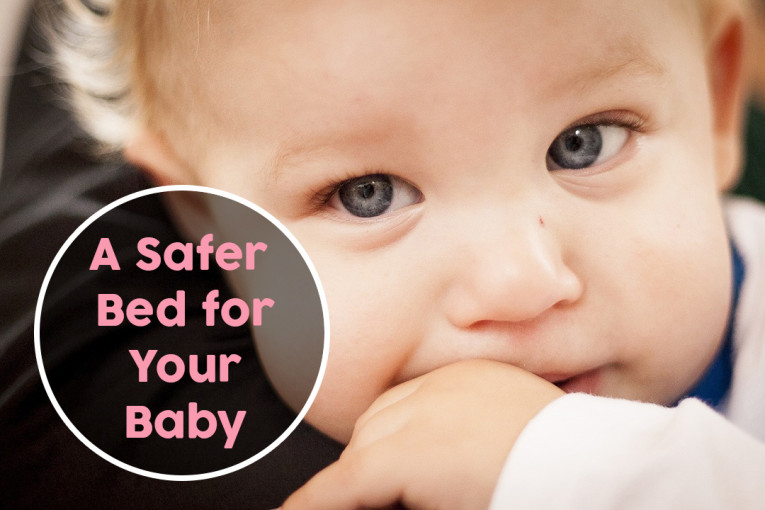Non Toxic Crib Mattress: A Safer Mattress for Your Baby
So, what is a non toxic crib mattress anyway? Are these mattresses 100% toxic free? Or perhaps they only contain a low level, and if so, that means it still contains chemicals, right? How do you find a non-toxic crib mattress?
In this write-up, we will walk-through all these questions. By the time you finish reading, you will have a good understanding of crib mattresses. Furthermore, you will know how to choose the best crib mattress for your baby.
Are you familiar with Volatile Organic Compounds and its associated health risks for children? These compounds, also known as VOCs, may have an impact towards the growth of babies. And in extreme cases, it may even lead to Sudden Infant Death Syndrome or SIDs.
Although companies must adhere to safety regulations such as the Consumer Product Safety Commission (CPSC) Fire Standard, often companies are rather reluctant to review their actual process of passing these standards.
Toggle For Table Of Content
Fragile Immune System
Babies and toddlers have a fragile immune system, so it is natural for you to be wary of harmful chemicals. And that is why you have to be extra careful when choosing a crib mattress. After all, your baby spends a long time sleeping.
Because of government regulations, mattresses sold in the market do not contain toxic substances. These includes fire retardants, plasticizers, polyurethane foam, and polyvinyl chloride (PVC).
Do companies conform to government regulations? For instance, the Consumer Product Safety Commission (CPSC) has a fire safety standard. How sure are we that some of the companies selling crib mattresses are compliant?
Different Between Toxic and Non Toxic Crib Mattress

When it comes to the word toxic, some people argue that it is subjective. For instance, we make a big deal out of chemicals and its potential toxicity. But others would say that chemicals make up everything in the world, and that includes us.
But we are not going to get into the debate, and instead, focus on your child's safety and health.The reason why we are to be wary is because companies are businesses. As such, they are likely to place a high importance on profit.
Now, businesses are good at conditioning our mind that we need their products. Furthermore, they are great at making us believe they are the best this and that. But we know there are companies which have lied or withheld information from the public.
Take Colgate, for instance. This is not the toothpaste company, but the one that manufactures crib mattresses. The company claims that all their materials are non-toxic. But they use polyurethane foam, which may be a cause for concern.
Let’s cut through the marketing hype. When companies refer to materials, they are referring to the main components. But during the manufacturing process to the finished mattress, they do use other substances.
We do not have a way to determine the minute details. In fact, detecting the traces of chemicals is possible only in laboratories.
Having said that, we can choose the best crib mattress on the basis of its reputation, as well as a good track record.
Let’s take a look at a few common toxic components we avoid at all costs.
Flame Retardants
The CPSC issued a standard called the Consumer Product Safety Improvement Act of 2008. All mattress manufacturers are to conform to the new standards. For example, mattresses must withstand a 30-second flame test.
On one hand, this ensures that a crib mattress will not burn within the blink of an eye. The flip side to this is that conforming to the flame test necessitates the use of another chemical.
So, what do some manufacturers use to make their crib mattress fire retardant? Some use Polybrominated Diphenyl Ethers (PBDEs). Unfortunately, these compounds may also be carcinogenic, according to this article.
For obvious reasons, something has to change. And change came under the Bureau of Home Furnishings and Thermal Insulation (BHFTI). In 2014, the agency updated the standard with Technical Bulletin 117-2013.
Good news came in 2014: Under Technical Bulletin 117-2013 by The Bureau of Home Furnishings and Thermal Insulation (BHFTI), new flammability standards now can be met WITHOUT the use of flame retardants chemicals.
In the updated standards, companies do not have to use PBDEs. But it does not ban its use, either. Whether there are companies continuing to use or not, we do not know. It is safe to assume, though, that there are companies using PBDEs as a matter of economics.
Tip: Look for the TB117-2013 label on new crib mattresses. This suggests that the item meets the standards without using fire retardant chemicals.
Plasticizers
As mentioned, during the manufacturing process, companies need to add different substances. For instance, adding plasticizers to form a material such as plastic into specific shapes. Its other uses include making plastic materials more resilient, flexible and easier to handle.
Of the hundreds of different types of plasticizers, up to 100 are in commercial use.
One of these plasticizers is Phthalates, of which six types are now banned by the CPSC.
Despite the ban, the presence of Phthalates may still be in the market. That is because there are already mattresses manufactured before the ban took effect.
Would there be some manufacturers which continue to use the banned components? It is within the realm of possibilities; hence it is important to choose a trusted brand.
Polyvinyl Chloride (PVC)
A compound called PVC, also known as vinyl, may be present in a mattress. If so, this is because of its ability to protect the inner foam. As for vinyl covers, they are easy to clean.
Unfortunately, the same compound added to prolong the life of crib mattress may also be toxic. In fact, it is also referred to as the poison plastic.

Even the World Health Organization’s International Agency labeled PVC a human carcinogen. So, the only way to avoid using PVC products is to identify it first! Commonly on any plastic packaging, look for the #3 or the letters “PVC” often found next to the three-arrow “recycling” symbol. For other PVC products, please contact the manufacturer and verify the product contents with them.
The Industry Comes to Its Defense
In any industry, businesses come to the defense of its products, or components they use. After all, that is how they earn.
Take for instance the use of parabens (preservatives) in beauty and skin care products. There are studies suggesting there is a link between parabens and breast cancer tumor. On the Internet, you will find websites and organizations defending the use of parabens. Usually, these organizations represent the businesses.
The same is true in the manufacture of crib mattresses and other children’s products.
In the interest of neutrality, here are arguments against plasticizers and phthalates.
Since we do not have the level of sophistication the so-called experts have, then it is prudent to err on the side of caution.
The Non Toxic Crib Mattress

Congratulations, you have made it here. At this point, you have a basic understanding of the dangers of chemicals. Now is a good time to take a look at what makes for a non-toxic crib mattress.
These are among the safest and non-toxic components for crib mattresses:
Organic wool (untreated). By nature, it is flame and mildew resistant. They are also great in inhibiting the proliferation of dust mites.
100% natural latex. Avoid latex blends, which may contain nasty chemicals such as petroleum-based polyurethane.
Organic cotton (grown in untreated soil, without pesticides). This safe for use in batting or mattress wrapping.
When the components of a crib mattress use materials such as organic wool and cotton, that is a good start. Let’s throw in 100% natural latex and innerspring coil, and you end up with a non-toxic crib mattress. Often, companies label this as “eco-friendly”.
Even so, what is on the label is not always true. Besides false claims, there’s also the undisclosed compounds. Furthermore, the crib mattress may also come with other parts or accessories. So, we want to be careful with anything else that comes with the crib mattress.
For your convenience, and especially comfort, go with mattresses that have other certifications. These are GREENGUARD, OEKO-TEX, and GOTS. These certifications are an added layer of protection for you.
If you have doubts on the claims of a manufacturer in certification, it is easy to check on the agency’s website.
Sharing Is Caring

Like what you read so far? How about help us to spread this AWESOME post to your friend and family? Your shout-out will help to motivate us to create more great posts for you and everyone else. Thanks for your support!
Check out this post for 'Non Toxic Crib Mattress: A Safer Mattress for Your Baby.'
Certification 101: Beware of Sneaky Certifications!
Let’s put some context on the importance and value of certifications. There are two reasons why manufacturers would like to have product certifications.
The first one is to adhere to the standards of the certification agency. This is a way for companies to manufacture higher quality products.
Another reason is that it is good for marketing.
Is there a certification that is more important than the others? Would there be certifications that are nothing more than gimmicks?
Let’s find out.
There are three basic types of certifications:
First-party certifications
As mentioned, certifications are good for marketing. And that is why some companies may create their own certifications. Often, these are certifications no one else has heard of.
An example is the National Association of Organic Mattress Industry (NAOMI). Ecobaby runs this organization for their own products.
Is this a legitimate certification?
The truth is that customers are smarter today than ever. A company that engages in such deception or misleading practices is not to trusted.
After all, it is fair to ask what other things are they hiding from us?
Second-party certifications
A second-party certification is one that trade associations created. In general, these certifications are reliable. Trade organizations comprise the manufacturers, and their main purpose is to represent their interests. Even so, it is also a way for them to self-regulate.
One such certification you will come across is the CertiPUR-US. This certifies that the manufacturer does not use PBDEs. But that doesn’t stop their members from selling polyurethane crib mattresses.
Third-party certifications
Third-party means it is non-partisan and has no relationship with the industry or manufacturer. As such, it is the most reliable of all certifications.
Among the agencies you will come across are:
- GREENGUARD. Helps manufacturers create, and buyers identify, interior products and materials that have low chemical emissions, as well as improving the quality of the air in which the products are used.
- OEKO-TEX. An international association of independent research and testing institutes focused on enhancing both product safety and sustainable production in the textile industry. The Association is made up of 16 member institutes with representative offices in more than 60 countries all over the world.
- Global Organic Textile Standard (GOTS). A worldwide leading textile processing standard for organic fibers, including ecological and social criteria, backed up by independent certification of the entire textile supply chain.
How to Spot a Non Toxic Crib Mattress
How do you find non-toxic crib mattress? The reality is this. If you are going to take away all possible contaminants, then you will end up not buying one.
And so, the best way to buy one is to start from the basics. The first step in buying a crib mattress is identifying the size.
From that, create a list of brands and models that fit the size you need.
After that, it is as simple as using the process of elimination.
As an option, you may click here to see our pick for the best crib mattress. Other information included are safety and care for crib mattresses.
The Thrifty Alternative to Costly, Non Toxic Mattresses
Let’s get one thing straight. Once you start looking around for the best crib mattress for your baby, you see the price differences.
We know for a fact that you are a smart person. You know when there is overpricing. Let’s set that aside for now.
How many times have we heard this, “You get what you pay for.”
When it comes to pricing for products for your precious baby, there is no such thing as expensive. But there is overpricing.
The right price of a crib mattress is the one that fits your need, the one that you want for your baby. Anything lower may be a result of using inferior materials, maybe even toxic chemicals.
Now, there are some people who may recommend that you buy a cheaper mattress. One that has GREENGUARD and CertiPUR certification. And then pair it with toxin-blocking covers from Harlow's Earth and Serendipity, both are the two more famous “toxin-blocking mattress covers” you can consider.
Conclusion
Finding a 100% non-toxic crib mattress is a challenge. As you learned, even if the main components are organic, there might be toxic additives.
But things are changing, so are the standards. Mainstream manufacturers make products based on price range. But there are others that put high-quality above anything else.
To help you simplify the process of searching for a crib mattress for your baby, click here.
Related Popular Posts
This post was last updated on 4 December 2016


